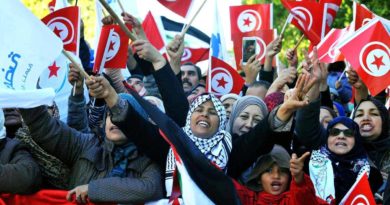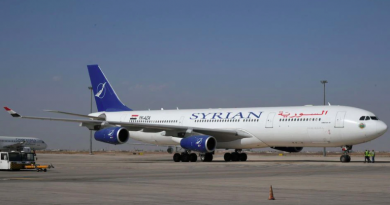ANALYSIS: Latest twist in ‘Salvator Mundi’ painting case again aims to target Saudi
by Seth J Frantzman
Once again there are people in the shadows coming out to talk about the painting.
The story has taken a new turn and it leads to questions about why “intelligence” officials had accused MBS of buying a painting that may have been tainted by disputed authenticity.
Back in 2017, Saudi Arabia’s Crown prince was criticized in the West for a crackdown on corruption that targeted many leading Saudis who had close connections to friends in New York, Washington, Paris, London and elsewhere. The narrative media presented at the time was that Mohammed Bin Salman, often called “MBS,” was cracking down on corruption at home but spending lavishly abroad.
Many of the articles were based on conjecture, rumors and innuendo, and some of them were pushed by Saudi’s critics in Qatar, Turkey and elsewhere. But others were written up as fact by leading publications.
For instance, The New Yorker claimed that MBS had bought a chateau near Paris and also “spent four hundred and fifty million dollars on ‘Salvator Mundi,’ the Leonardo da Vinci portrait of Jesus Christ, which he donated to the new branch of the Louvre in Abu Dhabi.” The New York Times reported in December 2017 that “last month, Leonardo da Vinci’s painting ‘Salvator Mundi’ sold.” A December 7 article at the Wall Street Journal had claimed that MBS was “identified as the buyer of da Vinci’s ‘Salvator Mundi.’”
The articles depicted the purchase as somehow controversial. One linked it to a “bauble” for the leading Saudi. Usually the story of wealthy Saudis or people buying expensive paintings is not an issue of national security or foreign policy.
But for some reason, because there were many people seeking to target the crown prince, the stories became saturated by quotes from former “intelligence” officers and others. Middle East reported that “Saudi Crown Prince Mohammed bin Salman used a proxy to buy the $450m Leonardo da Vinci painting the Salvator Mundi, the Wall Street Journal reported on Thursday, citing sources, including unidentified US intelligence officials.”
Now the story has taken a new turn, leading to questions about why “intelligence” officials had accused MBS of buying a painting that may have been tainted by disputed authenticity.
“The mystery of why the Salvator Mundi, the world’s most expensive painting, didn’t appear at the blockbuster 2019 Leonardo da Vinci show at the Louvre in Paris is unraveled in a new documentary, set to premiere on French television on April 13,” says the Art Net website.
Now a new documentary called Savior for Sale, “speaks with anonymous sources who claim that the plan to exhibit the work fell through because the Louvre refused to bow to demands from Saudi Arabia to show the painting as an autograph Leonardo, reports the Art Newspaper.”
According to the article, the museum is said to have conducted its own scientific analysis of the $450 million work, which smashed every auction record in history with its 2017 sale at Christie’s New York. The Louvre disagreed with the auction house’s billing of the work as ‘the male Mona Lisa,’ and the last painting by the Renaissance master to exist in private hands.”
Now the story is made more complex by the claims that Da Vinci “only made a contribution to the painting.” Once again there are people in the shadows coming out to talk about the painting. A man with a “code name Jacques” is interviewed in the film.
Once again this is a story that seems to go far beyond a painting; it looks like it is about international relations and the attempts of some countries to use national media to embarrass Saudi Arabia and its crown prince.
Iran’s Press TV put the story about the painting on its homepage. The Iranian report claims that MBS pressured the French to display the painting. “The Saudi crown prince did so to escape the public humiliation of having spent hundreds of millions of dollars to buy the painting credited to Italian Renaissance artist Leonardo da Vinci.”
According to this account, the painting failed to appear in Abu Dhabi or in Paris in 2019. Suddenly a story that was used to target MBS over contradictions regarding spending and corruption has become about trying to authenticate an expensive painting. Isn’t that a bit strange? The original reason we were told that this was a scandal was because of the appearance of wasteful spending.
But the painting had been purchased quietly and donated to Abu Dhabi’s Louvre, so what was the problem? Isn’t that philanthropy? Why did the crown prince’s name even appear since he hadn’t shown off the painting? Now the story shifts to claims that the Saudis tried to pressure France.
“The documentary showed that some members of the French government, including Foreign Minister Jean-Yves Le Drian, had lobbied on behalf of bin Salman’s request as they had been concerned about the impact on France’s wide-ranging strategic and economic relationship with Riyadh,” says Press TV.
According to reports, Le Drian “lobbied on behalf of the Saudi prince’s request, according to the documentary… [French President Emanuel] Macron decided to reject the prince’s request, leaving it to the Louvre to negotiate with the Saudis on how the painting should be presented,” The New York Post notes.
Another enemy of Saudi Arabia has jumped into the painting controversy again. Turkey’s TRT, which is run by the government and reflects the views of the ruling AK Party, has an article slamming the kingdom. “A French documentary has claimed that ‘Salvator Mundi,’ the world’s most expensive painting, was not exhibited at the Louvre in 2019 because experts doubted its authenticity. #WhereIsSalvatorMundi #LeonardoDaVinci #MBS,” says TRT.
So now the story has shifted from the lavish spending to wondering where the painting is. It’s almost like the narrative has gone from attacking Saudi Arabia for buying and donating the painting, to not showing the painting off enough.
What’s really going on here? Turkey’s President wasted massively on a new presidential palace with 1,000 rooms that cost some $600 million in 2014. Middle East regimes also have had expensive art in the past. Iran once had the Dutch expressionist Willem de Kooning painting named “Woman III” but hid it after it was deemed offensive following the Islamic Revolution in 1979. It was sold by David Geffen to Steven A. Cohen in 2006, according to Willem-de-Kooning.org.
So why does it matter which painting MBS purchased if he then donated it quietly? What is interesting is that a story that was supposedly about lavish spending is now once again coming to light in international relations, and now related to supposed pressure on France. Enemies of Saudi Arabia have shifted from complaining that a central figure in the kingdom quietly acquired and donated the painting to demanding to see the painting and claiming it may not be as authentic as originally thought.
If that’s the case, then it might be that someone had an interest in passing this off to the Saudis. If so, why? How did the painting sell for so much money only to have its authenticity questioned several years later? Why was the painting described as a da Vinci in 2017 without any questions?
The New York Post now reports that “the world’s most expensive painting was only partly made by Leonardo da Vinci – a revelation that allegedly sparked a cover-up and an international political scandal, according to a new documentary.”
The same article includes the following quote: “The Saudis are afraid of this debate on the authenticity,” said Chris Dercon, who heads one of France’s top museum groups and advises the Saudi government on art. “They are afraid that people will say, both at home and abroad, ‘You spent all this money for something that is not a da Vinci.’”
So the story went from 2017 when it was about spending too much amid anti-corruption arrests to simply spending too much on something that wasn’t what it was claimed to be? That should raise questions about what happened back in 2017, but instead it is yet again another story that appears to be targeting MBS, as opposed to dealings in the art world.
It seems perplexing that a painting would have been sold for so much money in 2017. The Art Newspaper noted in April 2019 that “The National Gallery is justifying its display of the controversial Salvator Mundi painting in its 2011-12 Leonardo exhibition, following critical comments in a new book by Ben Lewis. In The Last Leonardo, Lewis questions the attributional process and says that some specialists believe that it was partly painted by the master’s assistants. He also points out that the National Gallery’s presentation of it as a full Leonardo was used by Christie’s, when in 2017 the auction house sold the painting for $450m.”
In fact, this article notes that scholars cast doubt on the painting in 2008 and that some felt the whole painting had not been done by da Vinci. When Christi’s listed the painting in 2017, it was described as an autograph work by da Vinci, the article notes. “This judgement meant that Christie’s was able to sell the work as a full Leonardo, dating to around 1500. Without this firm attribution, it would have been impossible to achieve anything like the eventual price of $450m – making it by far the most expensive artwork ever sold.”
That sounds like a story that is more a scandal for the art world than Riyadh. It remains to be fully understood why and how the story has then been spun into something about MBS, involving anonymous sources, code names and intelligence officers. Unless, of course, the real story is about using a painting to somehow target the prince because he has many critics abroad.
In 2018 MBS was accused of being involved in ordering the killing of former Saudi dissident Jamal Khashoggi in Turkey. That was after the story about the painting in 2017, illustrating that pressure was already being brought on MBS about the painting. We may never know how and why this painting became such a lightning rod.
Article first published on Jerusalem Post.
Seth J Frantzman. Frantzman is Middle-East Security Analyst, and Director of the Middle East Center for Reporting and Analysis. He tweets under @sfrantzman.



